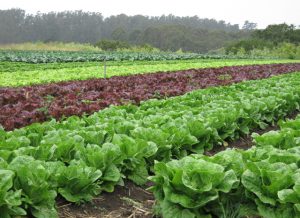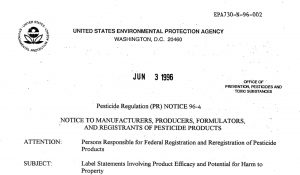Much will be said about the EPA’s October 31, 2018 decision to extend for two more years the conditional registration of the three dicamba-based herbicides registered for post-emergence, “over the top” (OTT) applications on soybeans and cotton.
The basics of the EPA’s decision are simple and not entirely meaningless in terms of reducing the extent of crop damage that will occur in 2019 and 2020, below what it would otherwise be.
But when will the herbicide companies, the EPA and USDA, and farmers finally accept that intensifying herbicide use is not a sustainable or affordable strategy in response to the spread of herbicide-resistant weeds.
The only virtue in this EPA decision is that it will shorten the time elapsed before we face the day of weed-management-system reckoning on corn, soybean and cotton farms reliant on GMO, herbicide-resistant seed technology.
That day will come because the bottomline is clear — these EPA-mandated label changes might cut the acreage damaged by dicamba by a few million acres in the next two years, below what it would otherwise be, but the big jump upward in acres planted to dicamba-resistant soybeans and cotton from about 50 million in 2018 to around 70 million in 2019 will increase the number of damaged acres by 10 million to 20 million in both 2019 and 2020.
–Dr. Robert Hartzler, Iowa State Extension (Begemann, 2018)
So, EPA’s decision will sanction a several-fold increase in the number of acres damaged in 2019 and then again in 2020, compared to 2018. And for mature trees and vines, dicamba damage is often cumulative. It can take 3-4 years to undermine the strength, and health, from trees and vines. Then, they can succumb quickly to some combination of environmental stress and opportunistic pathogens.
Specialists hired by the companies as expert witnesses in litigation will earnestly argue that some disease or infection killed the tree or vine, and that the cause of death could be many things. Other experts hired by plaintiffs will present data showing that dicamba exposure incrementally saps the strength and depresses the immune systems of plants, trees, or vines, setting them up for untimely death.
Without doubt, the nature of dicamba damage, and the people suffering the damage in 2019 and 2020 will differ markedly from 2017-2018, and average losses per acre damaged will rise sharply.
The number of acres of damaged soybeans and cotton will drop significantly, because 80% or more of the planted acreage to each crop will be dicamba-resistant. Plus, the economic costs per acre of damaged soybeans and cotton generally fall to the $35 to $100 per acre range.

High-value specialty crops, trees, shrubs, and vines will account for most of the economic damage in 2019-2020, and the hit per acre will be in the $100s to $1,000 or more per acre, just ask Steve Smith, who lost $9,000 of trees in his small yard in 2018.
I don’t know what it costs to replant an acre of peach trees on Bader Farms, or wine grapes on a Texas or Missouri winery, but I suspect the total economic damage per acre of peach trees or grape vines killed by dicamba will be many thousands of dollars.
First, the old trees and vines have to be taken out. The ground prepared for replanting. New trees and vines purchased and planted, and nurtured to 2-3 years before production begins. Add to these sizable, sunk costs, the loss of net income from harvests that did not happen.
No doubt the companies who manufacture dicamba and their surrogates pushed EPA to adopt this maintain-the-status-quo decision. By going along with the companies, the EPA has set the stage for many long weeks and months in court, in hundreds of courts across the Heartland for the foreseeable future, and with no end in sight.
Plaintiffs will include rural and suburban residents, both row and specialty crop growers, and eventually local units of government that manage schools, parks, and public spaces. Defendants will include Bayer, BASF, and the new Dow-DuPont hybrid Corteva Agriscience.
The legal wrangling over a little-known EPA Pesticide Registration Notice will determine the outcome of the vast majority of the cases —

In a nutshell, this hugely significant Pesticide Regulation (PR) notice states that pesticide registrants are responsible for crafting label language sufficient to prevent economic damage to private property. When registrant-drafted label provisions fail to do so — as they have in spades in the case of post-emergence dicamba labels — the PR Notice sets out two remedies.
First, the person suffering the economic damage asks the person responsible for it to pay up. Neighbor to neighbor, in that perfect world that never existed. Since it will always be very difficult to trace the dicamba damaging a crop, tree, or field to a specific application, this option won’t bring no relief.
The second option laid out in EPA’s PR Notice is for the parties suffering a loss of economic property to sue the manufacturer who crafted the deficient label language.
Cases triggered by drift and crop damage in 2016-2018 are already clogging the dockets in some courts. Just wait until 2020 and beyond, when the number of cases, impacted acreage, and damages in play will almost certainly be several-fold higher. Is this the best “Modern Ag” can do?
Source:
Sonja Begemann, “Industry Experts React To Dicamba Registration Renewal,” AgWeb, Accessed on: November 2, 2018.
Environmental Protection Agency, “Pesticide Regulation (PR) Notice 96-4: Notice to Manufacturers, Producers, Formulators, and Registrants of Pesticide Products,” Office of Prevention, Pesticides, and Toxic Substances, June 3, 1996.

